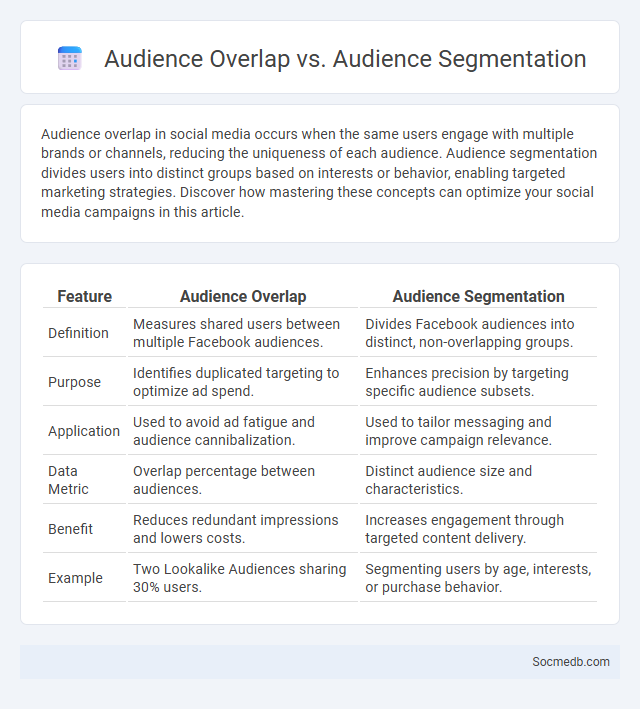
Photo illustration: Audience Overlap vs Audience Segmentation
Audience overlap in social media occurs when the same users engage with multiple brands or channels, reducing the uniqueness of each audience. Audience segmentation divides users into distinct groups based on interests or behavior, enabling targeted marketing strategies. Discover how mastering these concepts can optimize your social media campaigns in this article.
Table of Comparison
| Feature | Audience Overlap | Audience Segmentation |
|---|---|---|
| Definition | Measures shared users between multiple Facebook audiences. | Divides Facebook audiences into distinct, non-overlapping groups. |
| Purpose | Identifies duplicated targeting to optimize ad spend. | Enhances precision by targeting specific audience subsets. |
| Application | Used to avoid ad fatigue and audience cannibalization. | Used to tailor messaging and improve campaign relevance. |
| Data Metric | Overlap percentage between audiences. | Distinct audience size and characteristics. |
| Benefit | Reduces redundant impressions and lowers costs. | Increases engagement through targeted content delivery. |
| Example | Two Lookalike Audiences sharing 30% users. | Segmenting users by age, interests, or purchase behavior. |
Defining Audience Overlap
Audience overlap in social media occurs when the same group of users follows or interacts with multiple accounts or brands, creating intersections in follower bases that impact targeting strategies. Identifying audience overlap allows marketers to refine campaigns by avoiding redundant content delivery and optimizing ad spend for unique segments. Tools like Facebook Audience Insights and Twitter Analytics help quantify these intersections, enhancing segmentation accuracy and engagement rates.
What is Audience Segmentation?
Audience segmentation is the process of dividing your social media followers into distinct groups based on demographics, interests, behaviors, or location. This targeted approach allows you to create personalized content that resonates more effectively with each segment, boosting engagement and conversion rates. Understanding audience segmentation empowers your marketing strategy by delivering the right message to the right people at the right time.
Understanding the Target Audience
Understanding the target audience on social media involves analyzing demographics, interests, and online behaviors to tailor content that resonates with specific groups. You can leverage advanced analytics tools to gather insights about audience preferences, engagement patterns, and peak activity times. This strategic approach enhances content relevance, boosts user interaction, and drives higher conversion rates.
Key Differences Between Audience Overlap and Segmentation
Audience overlap refers to the extent to which the same users engage with multiple social media channels or campaigns, highlighting shared demographics and behaviors across platforms. In contrast, audience segmentation involves dividing users into distinct groups based on specific criteria such as interests, age, location, or engagement patterns to tailor content and improve targeting precision. Understanding these differences enhances campaign efficiency by optimizing reach without redundancy and delivering personalized messaging to segmented user groups.
The Role of Target Audience in Effective Marketing
Understanding the target audience is essential for effective social media marketing, as it allows brands to tailor content that resonates with specific demographics, interests, and behaviors. Data-driven audience segmentation enhances engagement by delivering personalized messages through platforms like Instagram, Facebook, and TikTok. Prioritizing the target audience's preferences and needs leads to higher conversion rates and improved return on investment (ROI) in social media campaigns.
Benefits of Audience Segmentation for Brands
Audience segmentation enhances your social media strategy by allowing brands to deliver personalized content that resonates with specific target groups, boosting engagement and conversion rates. By analyzing demographic, psychographic, and behavioral data, brands can optimize ad spend and improve campaign effectiveness. This tailored approach fosters stronger customer relationships and drives higher return on investment (ROI).
Challenges of Managing Audience Overlap
Managing audience overlap on social media platforms presents significant challenges in targeting efficiency and resource allocation. Brands often struggle with duplicated content exposure, leading to diminished engagement rates and increased advertising costs. Accurate segmentation and cross-channel analytics are essential to identify overlapping user segments and optimize campaign performance effectively.
Strategies to Identify and Minimize Audience Overlap
Analyzing audience demographics and engagement metrics across multiple social media platforms helps identify overlapping user segments, enabling targeted content differentiation. Leveraging advanced tools such as audience segmentation software and cross-platform analytics ensures precise overlap detection and effective allocation of advertising budgets. Optimizing posting schedules and customizing content for each platform minimizes redundancy, enhancing overall reach and engagement while reducing audience fatigue.
Integrating Audience Segmentation With Target Audience Strategies
Integrating audience segmentation with target audience strategies enhances social media marketing by delivering personalized content tailored to specific demographics, behaviors, and interests. Leveraging data analytics tools like Facebook Audience Insights and Google Analytics allows precise targeting, improving engagement rates and conversion. This method optimizes ad spend and maximizes ROI by focusing on high-value segments within platforms like Instagram, LinkedIn, and Twitter.
Best Practices for Maximizing Audience Impact
Optimizing social media content involves posting consistently to maintain audience engagement and using analytics tools to track performance metrics. Crafting visually appealing, relevant posts tailored to your target demographic enhances user interaction and shareability. You should also leverage platform-specific features like hashtags and stories to increase reach and foster community growth.
 socmedb.com
socmedb.com